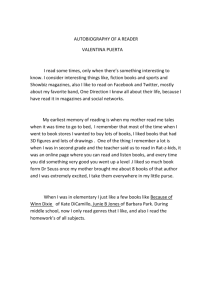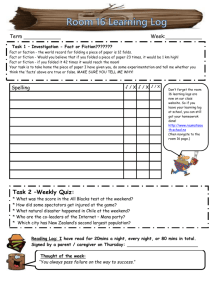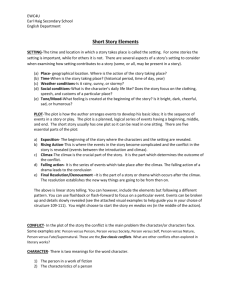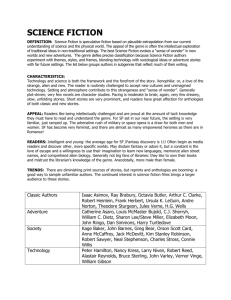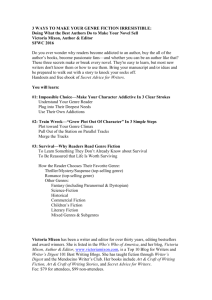Literature
advertisement
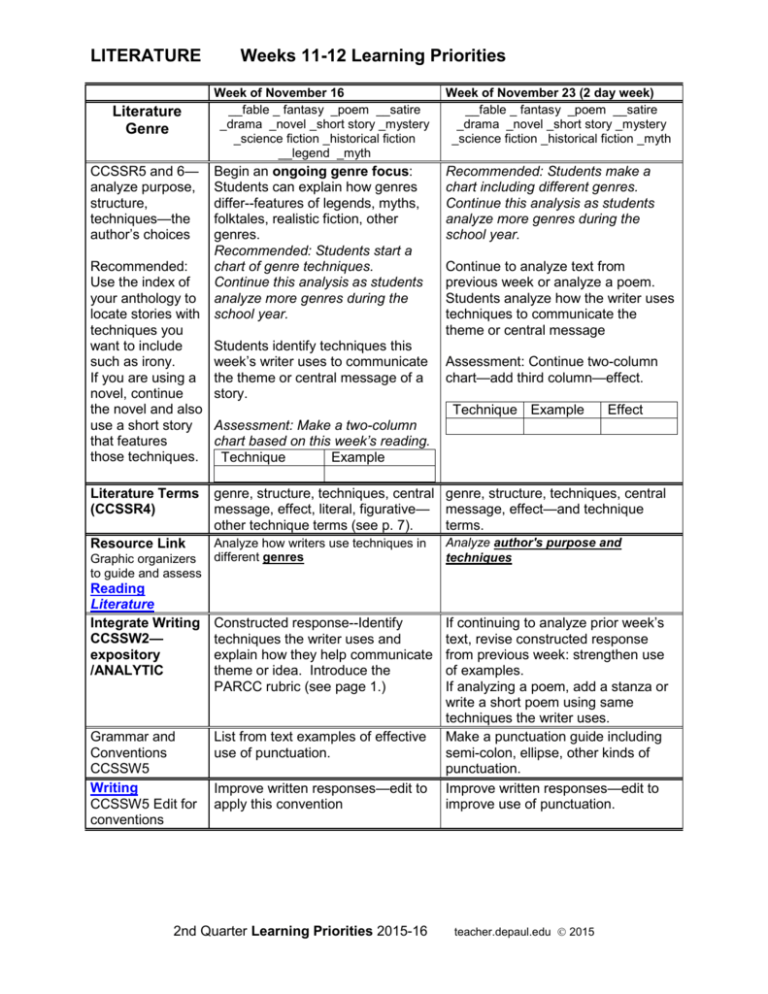
LITERATURE Literature Genre CCSSR5 and 6— analyze purpose, structure, techniques—the author’s choices Recommended: Use the index of your anthology to locate stories with techniques you want to include such as irony. If you are using a novel, continue the novel and also use a short story that features those techniques. Literature Terms (CCSSR4) Weeks 11-12 Learning Priorities Week of November 16 __fable _ fantasy _poem __satire _drama _novel _short story _mystery _science fiction _historical fiction __legend _myth Week of November 23 (2 day week) __fable _ fantasy _poem __satire _drama _novel _short story _mystery _science fiction _historical fiction _myth Begin an ongoing genre focus: Students can explain how genres differ--features of legends, myths, folktales, realistic fiction, other genres. Recommended: Students start a chart of genre techniques. Continue this analysis as students analyze more genres during the school year. Recommended: Students make a chart including different genres. Continue this analysis as students analyze more genres during the school year. Students identify techniques this week’s writer uses to communicate the theme or central message of a story. Technique Example Effect genre, structure, techniques, central genre, structure, techniques, central message, effect, literal, figurative— message, effect—and technique other technique terms (see p. 7). terms. Analyze how writers use techniques in Graphic organizers different genres to guide and assess Grammar and Conventions CCSSW5 Writing CCSSW5 Edit for conventions Assessment: Continue two-column chart—add third column—effect. Assessment: Make a two-column chart based on this week’s reading. Technique Example Resource Link Reading Literature Integrate Writing CCSSW2— expository /ANALYTIC Continue to analyze text from previous week or analyze a poem. Students analyze how the writer uses techniques to communicate the theme or central message Constructed response--Identify techniques the writer uses and explain how they help communicate theme or idea. Introduce the PARCC rubric (see page 1.) List from text examples of effective use of punctuation. Improve written responses—edit to apply this convention 2nd Quarter Learning Priorities 2015-16 Analyze author's purpose and techniques If continuing to analyze prior week’s text, revise constructed response from previous week: strengthen use of examples. If analyzing a poem, add a stanza or write a short poem using same techniques the writer uses. Make a punctuation guide including semi-colon, ellipse, other kinds of punctuation. Improve written responses—edit to improve use of punctuation. teacher.depaul.edu 2015 LITERATURE Literature Genre Reading Literature Analyze techniques (CCSSR5) and infer purpose (CCSSR6) CCSSR.9 contrast literature with same theme (CCSSR2) Weeks 13-14 Learning Priorities Week of November 30 __fable _ fantasy _poem __satire _drama _novel _short story _mystery _science fiction _historical fiction _myth Week of December 7 __fable _ fantasy _poem __satire _drama _novel _short story _mystery _science fiction _historical fiction _myth Analyze how writers of two different Continue analysis of how writers of two genres communicate a parallel theme—example, poem and story, myth and legend. You could include a story read previously. This analysis continues in the following week—the constructed response essay that students compose is based on this week’s readings. Infer author’s purpose— development of the theme or lesson-- and analyze techniques author uses to achieve it— examples, tone, setting, characterization, figurative language different genres communicate the same theme. Infer author’s purpose—development of the theme or lesson-- and analyze techniques author uses to achieve it— examples, tone, setting, characterization, figurative language authors develop it. characterization, figurative characterization, figurative language, language, tone, author, purpose, conflict, conflict resolution, elements of fiction, plot structure analyze, compare, contrast Resource link: Analyze how writers use techniques in different genres tone, author, purpose, conflict, conflict resolution, elements of fiction, plot structure analyze, compare, contrast Resource Link: Analyze author's purpose and techniques Integrate Writing CCSSW2— expository /ANALYTIC Constructed response—outline a comparison/contrast analysis of two different texts (based on the readings of the week). Use the PARCC rubric to review the outline and adjust it (see page 1 for link to rubric.) Write the constructed response Grammar and Conventions Make a guide to grammar correction with examples of subject-verb agreement and tense that you correct. Check your writing of the constructed response for subject-verb agreement and tense. Use a thesaurus to identify words that are useful to write about a writer’s techniques. Use thesaurus to identify words to enhance the constructed response. Literature Terms (CCSSR4) Resource Links Graphic organizers to guide and assess Reading Literature CCSSW5— improve writing Writing CCSSW5 edit for grammar and usage to improve writing. 2nd Quarter Learning Priorities 2015-16 based on the outline from last week. Improve it using the PARCC rubric. teacher.depaul.edu 2015 2 LITERATURE Week 15 Learning Priorities Literature Genre Week of December 14 __fable _ fantasy _poem __satire _drama _novel _short story _mystery _science fiction _historical fiction __legend _myth Analyze the role of the narrator in a story. Analyze the writer’s use of dialogue in a story. Reading Literature CCSSRL2 theme CCSSR5 analyze author’s techniques and choices to develop the plot Literature terms tone, voice, perspective, colloquialism, informal language, emotion, conflict Narrator first person second person third person omniscient Resource Links Resource links: Graphic organizers to guide and assess Analyze the Narrator's Effects on the Mood of a Story Compare the Feelings of the Narrator and a Character Analyze the Narrator's Point of View in Two Stories Reading Literature Integrate Writing Add dialogue to a story CCSSW3—narrative Grammar and Conventions Make the story editor’s guide to using correct grammar. CCSSW5— improve writing Make a story writer’s guide to using dialogue that includes Writing CCSSW5 edit for grammar and usage to improve writing. colloquialisms and other techniques. 2nd Quarter Learning Priorities 2015-16 teacher.depaul.edu 2015 3 LITERATURE Weeks 16-17 January 4 __fable _ fantasy _poem Literature Genre __satire _drama _novel _short This two-week sequence story _mystery _science fiction starts with fiction, _historical fiction continuing the week 15 __legend _myth focus on narrator and dialogue. Reading Literature CCSSRL2 theme CCSSR5 analyze author’s techniques and choices to develop the plot Literature terms Resource Links Graphic organizers to guide and assess Reading Literature Analyze the role of the narrator in a story. Analyze the writer’s use of dialogue in a story. tone, voice, perspective, colloquialism, informal language, emotion, conflict Narrator first person second person third person omniscient Resource links: Add dialogue to a story Grammar and Conventions Make the story editor’s guide CCSSW5 edit for grammar and usage to improve writing. fiction communicate ideas. Analyze how authors of plays use dialogue and other techniques to create a mood. Compare the use of chapters in a novel to scenes in a drama. stage directions, pacing, scene, theme, dialogue, tension, mood Resource Link: Add a scene to a play. Use the PARCC Constructed Response to set criteria for the scene. (Link is on page 1.) to using correct grammar and punctuation, including quotation marks. Use sentence expansion to Writing Contrast how authors of drama and Analyze the Narrator's Effects Expand Thinking with Drama on the Mood of a Story Compare the Feelings of the Narrator and a Character Analyze the Narrator's Point of View in Two Stories Integrate Writing CCSSW3—narrative CCSSW5— improve writing January 11 Include drama at this point as a contrast to fiction. __drama improve the dialogue in the play. 2nd Quarter Learning Priorities 2015-16 Improve the scene in the play based on conventions and on requirements for effective dialogue such as use of patterns of speech consistent with a character, teacher.depaul.edu 2015 4 LITERATURE Weeks 18-19 Priorities Literature Genre Reading Literature CCSSR8 analyze support for a message in a speech. CCSSRL 9— compare/contrast two readings on same topic/theme—emphasis on techniques of the writer (CCSSR5) Literature terms Week of January 18 __speech Week of January 25 __speech Determine the central message Determine the central message of a speech. of a speech. Analyze how the writer develops Analyze how the writer develops it—what examples support it. it—what examples support it. Analyze author’s use of words, Analyze author’s use of words, examples, comparisons, contrasts, symbols, similes, other techniques to accomplish purpose examples, comparisons, contrasts, symbols, similes, other techniques to accomplish purpose Evidence, support, reliability, Evidence, support, reliability, strength, example Resource Links Graphic organizers to guide and assess Reading Literature strength, example Persuasive Speeches, Poems Persuasive Speeches, Poems and Songs and Songs Analyze Arguments Analyze then Create a Analyze Arguments Analyze then Create a Persuasive Song Persuasive Song Analyze a speech. Evaluate the Contrast two speeches. Decide Writing strength of evidence provided to which of the two provides the Constructed response support the central claim. stronger and more reliable Analytic writing support. Improve your response— (CCSSW2) strengthen the use of transitions. Improve another student’s response for use of transitions. Grammar and Conventions CCSSW5— Word structure and context Writing CCSSW5 edit for grammar and usage to improve writing. Explain with examples how to Explain with examples how to use structure (root-prefixsuffix) to determine word meaning in text. use these strategies to figure out an unknown word: Structure of the word (root/affix) Context Improve the use of verbs in the analysis you wrote. Use verbs that are clear and specific. 2nd Quarter Learning Priorities 2015-16 Improve the use of adjectives in the analysis you wrote. Increase them and strengthen them. teacher.depaul.edu 2015 5 LITERATURE Weeks 20 Priorities This end-of-semester week is an opportunity to clarify the learning progress and set specific goals for the next semester. Literature Genre Reading Literature Comprehensive: CCSSR2—theme CCSSR3—plot and character development CCSSR5—craft and structure (CCSSR6) Literature Terms Week of February 1 __fable _ fantasy _poem __satire _drama _novel _short story _mystery _science fiction _historical fiction _myth Analyze an unfamiliar text: Author’s purpose, message—moral or theme of the text--and how the author achieves it— techniques, characters, sequence of events, other elements the author uses to communicate effectively. Complete the quarter’s chart of genres. Students make glossary with examples of the literature and persuasive text terms they have used this semester. Make guide to writing a constructed response Writing Constructed response Then use it to write a constructed response to an unfamiliar text. Recommended: Use a PARCC sample. Grammar and Conventions CCSSW5— improve writing Writing Improving writing (CCSSW5) Make a checklist with examples of what grammar and punctuation and word usage rules to follow in writing. Use the checklist to improve the constructed response 2nd Quarter Learning Priorities 2015-16 teacher.depaul.edu 2015 6



